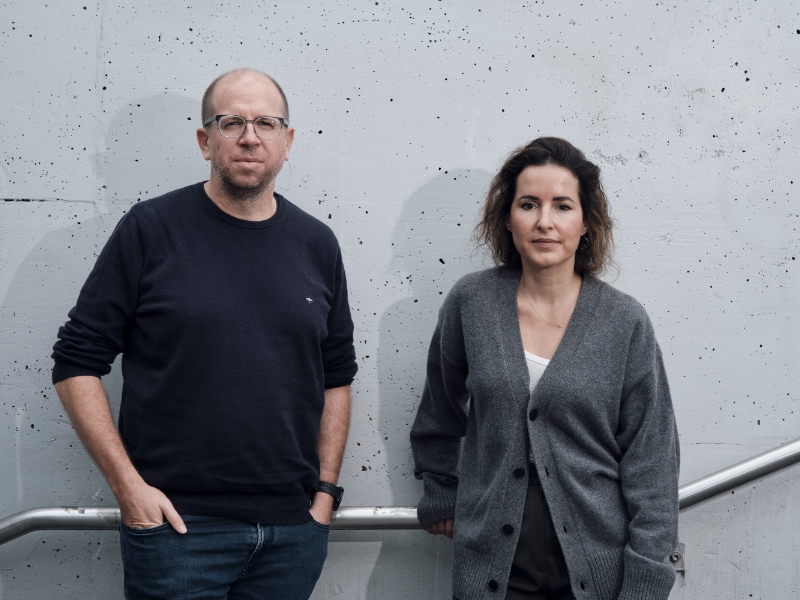2nd Bern Climate Law Conference
Climate protection in the gray area
Watching Netflix, eating tropical fruits, wearing cheap fashion—most greenhouse gas emissions are caused by imported goods and services. A conference at the University of Bern is focusing on these "gray emissions".

At first glance, Switzerland looks like a model climate student: Since 1990, its domestic greenhouse gas emissions have fallen by around a quarter, contrary to the global trend. By 2030, emissions are to fall by a total of 50 percent compared with 1990. In view of the measures taken so far, this is unfortunately too ambitious a goal, says Thomas Frölicher, climate researcher at the Oeschger Centre for Climate Change Research (OCCR) at the University of Bern: “I think it is unlikely that Switzerland will achieve its climate targets and reduce emissions by half again in the next five years. But at least we are moving in the right direction.”
More worries are caused by the “gray emissions”. If these factors are included in the greenhouse gas inventories, the image of Switzerland as a model climate student becomes considerably gloomier at a second glance. The term
“gray emissions” refers to greenhouse gas emissions generated through the production and use of imported goods and services, as well as their disposal and depreciation.
Switzerland is world champion – in terms of gray emissions
If you think of gray emissions from avocados imported from Peru or cheap T-shirts from Bangladesh, you are not wrong in principle. The emissions generated by digital media and streaming are also significant – the servers of Netflix and other streaming services are located in the United States after all. However, mobility and infrastructure are among the main contributors: With Holcim, for example, Switzerland is home to one of the largest cement producers in the world. Still, producation almost exclusively takes place abroad.
As a financially strong but resource-poor country, Switzerland imports a comparatively large number of goods. At an estimated 75 million tons of CO₂ equivalents per year, its gray emissions are nearly twice as high as domestic emissions (currently around 41 million tons). Since 2000, according to Thomas Frölicher, the proportion of gray emissions has risen slightly. In almost no other country in the world do gray emissions account for such a high proportion of the total carbon footprint. “From this point of view, Switzerland is world champion,” says Frölicher, “but unfortunately not in football.”
About the person

Thomas Frölicher
is a full Professor of Climate and Environmental Physics (KUP), and was part of the Swiss delegation at the UN Ocean Conference. He studied Environmental Sciences at ETH Zurich and received his doctorate in physics from the University of Bern. He then worked as a postdoc at Princeton University in the US for several years. In 2019, he was awarded the Theodor Kocher Prize by the University of Bern. He heads the Ocean Modeling Research Group at the Oeschger Centre for Climate Change Research (OCCR) and the Climate and Environmental Physics Department and will play a key role as Coordinating Lead Author in the next IPCC report.
A legal gray area
Despite their significance, gray emissions receive little attention in public debates on climate policy. For climate law expert Charlotte Blattner, the reason for this also lies in the legal framework: “Climate law mainly focuses on domestic emissions. Gray emissions, by contrast, remain in a legal gray zone where responsibility is still poorly defined.”
Blattner, an associate researcher at OCCR who has recently become a professor at the Centre de droit public at the University of Lausanne, conducts research on international and national climate protection law. The legal aspect is becoming increasingly important in the climate debate, she says – not least because of the growing number of climate lawsuits. For example, the successful lawsuit against Switzerland brought by KlimaSeniorinnen before the European Court of Human Rights (ECtHR) made headlines. For the first time, the Court recognized protection against the consequences of global warming as a human rights issue.
With its advisory opinion published in July 2025, the International Court of Justice (ICJ) has now also made it clear that states are obliged under international law to take into account the cross-border effects of their climate policy – according to Blattner a point that is of particular relevance when dealing with gray emissions.
“We are outsourcing responsibility abroad”
As far as climate law is concerned, Switzerland lags behind numerous countries, says Blattner. The situation regarding gray emissions is particularly sensitive because Switzerland wants to achieve its climate targets to a large extent by means of offsetting projects abroad. In Peru, for example, the federal government is financing the construction of 60,000 low-emission stoves for private households and allowing climate certificates to be credited towards this. However, it is difficult to reliably prove whether such projects actually bring additional emission savings.
In this way, two forms of outsourcing arise: On one hand, local consumption causes a disproportionately large number of emissions abroad, on the other, savings are also to be achieved there. “This means that we are not only outsourcing our CO₂ emissions abroad, but also a large part of our legal responsibility,” says Blattner.
About the person

Charlotte Blattner
is Professor of Administrative and Environmental Law at the Centre de droit public of the University of Lausanne and, as an associate researcher, heads the research group “Climate Change and Law” at the Oeschger Centre for Climate Change Research (OCCR). Until 2024, she worked as a senior assistant at the Institute of Public Law at the University of Bern. Previously, she did postdoctoral research at Harvard Law School in Boston (USA) and at Queen’s University in Kingston (Canada). In 2022, together with other Bern researchers, she submitted a third-party intervention in the case of the KlimaSeniorinnen (a group of senior women campaigning for climate protection) against Switzerland to the European Court of Human Rights (ECtHR) in Strasbourg.
Climate Law Conference pools expertise
For the first time, gray emissions will be the subject of a dedicated conference, “2nd Bern Climate Law Conference,” which will take place at the end of October at the University of Bern (see box). The conference, co-organized by Charlotte Blattner, examines the gray emissions from a climate science, international law, trade law and national law perspective. In addition to leading researchers, representatives from administration, business and NGOs will also take part. The aim is to examine gray emissions from multiple perspectives and to explore the legal and political options for effective action.
The following questions will be discussed during the conference: Where and with which economic processes do gray emissions arise – and how are they recorded? Who is legally responsible: Consumers, importing countries such as Switzerland or internationally active companies? And finally: Which policy or market-based instruments can actually help reduce gray emissions?
“Public debate needs momentum”
In addition to researchers from Bern, Lausanne, Zurich and abroad, representatives from practice also have their say. For example, Christina Meier, Head of Sustainability at SBB, reports on how a large transport company measures and reduces its gray emissions.
“Gray emissions are such a big problem that we can only tackle them if we find the broadest possible interdisciplinary approach,” says Charlotte Blattner. Climate researcher and keynote speaker Thomas Frölicher adds: “The public debate on gray emissions urgently needs momentum. Switzerland could not only fail to meet its domestic climate targets; it also continues to contribute to high emissions abroad through imports.”

Climate law at the University of Bern
Legal aspects of climate protection are increasingly coming into focus at the University of Bern:
- Bern Climate Law Conference 2025: The biennial series builds a bridge between law and other scientific disciplines as well as climate science, politics, economics and social research. The first issue in 2023 focused on climate-damaging subsidies. The 2nd Bern Climate Law Conference, which is now dedicated to gray emissions, will take place at UniS on October 30 from 9.15 am to 4.45 pm in 2025. The paid event is aimed at an interested audience from science, practice and politics.
- Hans Sigrist Symposium 2025: This year’s Hans Sigrist Symposium is dedicated to the question of how the diverse demands for climate justice can be meaningfully integrated into law. The Hans Sigrist Prize, which is endowed with CHF 100,000, will also be awarded during the symposium.
- Chair of Climate Law: The University of Bern is currently establishing the endowed professorship “Climate and Law”. The professorship will be based at the Institute of Public Law within the Faculty of Law and affiliated with the Oeschger Centre for Climate Change Research (OCCR). The purpose of the chair is to build strong expertise in climate protection law – both within Switzerland and in international and interdisciplinary contexts.
Subscribe to the uniAKTUELL newsletter

Discover stories about the research at the University of Bern and the people behind it.

